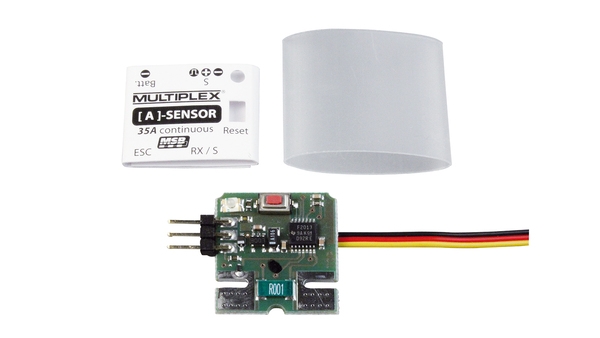Description
"Nothing going on without electricity"
- therefore the information about the currents in the model is vital!
This is where the current sensors come into play. They actually have two functions:
A - The measurement of the currently flowing currents in the drive, receiver or ECU battery (in jets). Interesting, e.g. to optimize the drive (how much current does my drive draw with which propeller) and to avoid overload situations. For example, with the basic setting of the model, blocking currents indicate incorrectly set servo travel.
B - Indication of the remaining amount of charge, so to speak the "fuel gauge" for the battery. Especially when using modern high-performance LiPo batteries (e.g. Li-BATT FX), the indication of the remaining charge is actually indispensable, since these batteries keep the voltage almost constant during operation for a long time , but then "break in" within seconds. This means that voltage-dependent monitoring, e.g. of the receiver battery, is no longer sufficient. Even timers can only be rough tools.
The sensor is looped in between the battery and consumer, and suitable high-current connectors (for # 8 5404) or cables (for # 8 5404 or # 8 5405) are soldered to the soldering surfaces. The sensors are connected to telemetry-capable receivers or to another sensor within the MSB. With its basic function "output of the currently flowing current in A", the sensor can be put into operation immediately, for example to measure the current of the electric drive.
After activating the charge counter with the RESET button on top of the current sensor, you will no longer fly according to the timer, but according to the actual remaining charge of the drive battery. The current sensor thus becomes your electronic fuel gauge!
Protect your batteries from discharging too deeply and thus prevent a shortened service life.
The MULTIPLEX MSB sensor is developed and built in Germany. QualityMade in Germany!
MSB = MULTIPLEX sensor bus
• Intelligent sensors with sensor bus system (MSB)
• Up to 16 sensors can be connected in series
• No additional sensor box required
- therefore the information about the currents in the model is vital!
This is where the current sensors come into play. They actually have two functions:
A - The measurement of the currently flowing currents in the drive, receiver or ECU battery (in jets). Interesting, e.g. to optimize the drive (how much current does my drive draw with which propeller) and to avoid overload situations. For example, with the basic setting of the model, blocking currents indicate incorrectly set servo travel.
B - Indication of the remaining amount of charge, so to speak the "fuel gauge" for the battery. Especially when using modern high-performance LiPo batteries (e.g. Li-BATT FX), the indication of the remaining charge is actually indispensable, since these batteries keep the voltage almost constant during operation for a long time , but then "break in" within seconds. This means that voltage-dependent monitoring, e.g. of the receiver battery, is no longer sufficient. Even timers can only be rough tools.
The sensor is looped in between the battery and consumer, and suitable high-current connectors (for # 8 5404) or cables (for # 8 5404 or # 8 5405) are soldered to the soldering surfaces. The sensors are connected to telemetry-capable receivers or to another sensor within the MSB. With its basic function "output of the currently flowing current in A", the sensor can be put into operation immediately, for example to measure the current of the electric drive.
After activating the charge counter with the RESET button on top of the current sensor, you will no longer fly according to the timer, but according to the actual remaining charge of the drive battery. The current sensor thus becomes your electronic fuel gauge!
Protect your batteries from discharging too deeply and thus prevent a shortened service life.
The MULTIPLEX MSB sensor is developed and built in Germany. QualityMade in Germany!
MSB = MULTIPLEX sensor bus
• Intelligent sensors with sensor bus system (MSB)
• Up to 16 sensors can be connected in series
• No additional sensor box required
Downloads

 EN
EN DE
DE FR
FR